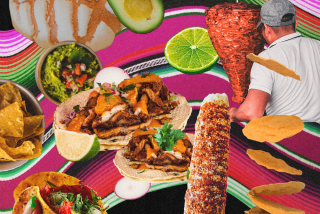It’s the sizzle they sell, not the steak
- Share via
The United States is a big, beefy, carnivorous country, the home of the Whopper, the land of the Kansas City sirloin, the Philly cheese steak, the New York strip steak, Buffalo wings, Cincinnati chili, and the Tex-Mex beef-and-chicken burrito combo platter, plus such traditional American fare as Swedish meatballs, Polish sausage and General Tso’s chicken.
And now, at long last, America has a magazine about meat. It’s called Meatpaper, and it’s a tasty little morsel.
But don’t get the wrong idea: Meatpaper is not the kind of practical magazine that’s likely to publish a story called “10 Hot New BBQ Tips for Sizzlin’ Summer Cookouts!” It’s the kind of arty, cheeky, ironic magazine that just published a story called “Sweat Sock: The Other White Meat.”
Meatpaper isn’t really about meat, it’s about “the idea of meat,” the editors explained in the first issue last fall. “Half the people who pick up Meatpaper assume it’s some kind of vegan hate letter addressed to their salami sandwich. The other half wonder if we’re subsidized by the National Cattlemen’s Beef Assn. That’s how we know we’re on to something.”
They are on to something: The notion that meat and the endless variety of rituals, symbolism and taboos surrounding it can tell us a lot about our fellow humans.
In the quarterly’s spring issue, for instance, Jeffrey Yoskowitz’s article, “Pork in the Promised Land,” discusses the bitter battle over pork in Israel, where arsonists recently torched delicatessens that dared to sell the flesh of the pig.
Pork isn’t kosher, of course. But in the last 20 years, it has become popular among secular Israelis, not only as a tasty dish but as a means of protesting against the power of Orthodox religious groups.
“As the arsons, ‘smear campaigns’ and pork-politicking attest,” Yoskowitz writes, “the controversy over pork prohibition in Israel exposes an underlying tension between democracy and religion in a nation in constant battle over its own identity.”
In another piece in Meatpaper’s spring issue, Bonnie Powell, author of a “food-politics blog,” discusses the eating of lamb, calf and goat testicles, which are regarded in some Middle Eastern and Asian cultures as a way for men to enhance their sexual powers. There seems to be no female counterpart to that belief.
“These are mostly masculine fantasies,” Krishnendu Ray, who teaches “food studies” at New York University, told Powell. “Rarely do people eat breasts to get bigger breasts.”
Not all of Meatpaper’s articles are serious sociological studies. Some, like the aforementioned “Sweat Sock: The Other White Meat,” are just plain wacky.
Chris Colin, a columnist for the San Francisco Chronicle, got the idea for “Sweat Sock” when he interviewed “food stylist” Kim Konecny, who earns her living making food look delicious in magazine photos by adding fake grill marks and arranging it artistically on plates.
Colin was so impressed with Konecny’s artistry that he figured she could make anything look appetizing. He decided to test that theory by using her grilling-and-plating techniques on a sweat sock, a plush toy, a copy of a John le Carre novel and a clown nose.
After the grilling -- “these things smell terrible when you barbecue them” -- Colin arranged his delicacies on plates, garnished them with vegetables, and photographed them.
Alas, none looks particularly appetizing. No matter how much parsley and lemon you put on the plate, a grilled sweat sock still looks a lot like a grilled sweat sock.
More to Read
Eat your way across L.A.
Get our weekly Tasting Notes newsletter for reviews, news and more.
You may occasionally receive promotional content from the Los Angeles Times.







